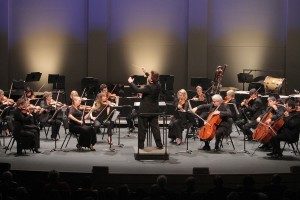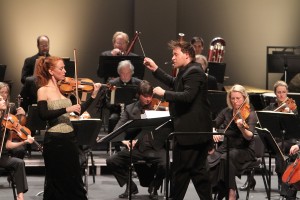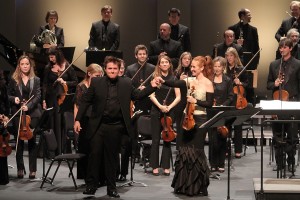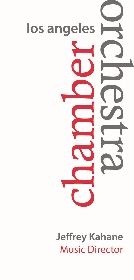BENJAMIN WALLFISCH DEBUTS HIS FIRST VIOLIN CONCERTO WITH LACO
Benjamin Wallfisch, a burgeoning conductor and composer known primarily for his work on film and television scores, made his Los Angeles Chamber Orchestra (LACO) debut conducting the world premiere of his own Violin Concerto. Guest conductor Wallfisch towered over the podium at UCLA’s Royce Hall, and led the orchestra with measured ferocity through three dense works: his Violin Concerto, Elgar’s Introduction and Allegro for Strings, Op. 47, and Beethoven’s Symphony No. 2 in D Major, Op. 36.
 Right out of the gate, Elgar’s Introduction and Allegro for Strings was conducted with fevered gesticulation; like a man playing charades. And though there was juxtaposition between his movements and the orchestra’s sound, the work was nonetheless strong, albeit with some uneven passages that lacked vibrancy or crisp timing. However, whatever notions of doubt were raised as the Allegro for Strings ended, dispelled quickly with the world premiere of Wallfisch’s Violin Concerto, commissioned by LACO for their assistant concert master, violinist Tereza Stanislav (commemorating her 10th anniversary with the orchestra). Intricate, layered, and dense, the work sounded the most difficult of the three, but also the most masterfully accomplished. Stanislav shined as she gave a masterful, full-bodied, Technicolor performance that overflowed with vigor and flair.
Right out of the gate, Elgar’s Introduction and Allegro for Strings was conducted with fevered gesticulation; like a man playing charades. And though there was juxtaposition between his movements and the orchestra’s sound, the work was nonetheless strong, albeit with some uneven passages that lacked vibrancy or crisp timing. However, whatever notions of doubt were raised as the Allegro for Strings ended, dispelled quickly with the world premiere of Wallfisch’s Violin Concerto, commissioned by LACO for their assistant concert master, violinist Tereza Stanislav (commemorating her 10th anniversary with the orchestra). Intricate, layered, and dense, the work sounded the most difficult of the three, but also the most masterfully accomplished. Stanislav shined as she gave a masterful, full-bodied, Technicolor performance that overflowed with vigor and flair.
 Wallfisch cooked up something delectably dark and riveting as his concerto’”comprised of an introduction and three movements’”begins with a chilling motif that climbs to ear-splittingly high notes. Stanislav retained extraordinary control throughout whether she was playing powerfully or pulling back no matter where her hands were on the violin. Her vibrato and attack were tremendous; no small feat for a work that requires the fullest use of a violin handled by an appropriately sensational violinist. The orchestra blended best on this work as well; their soundscapes further augmented the foreboding and mournful atmosphere with excellent balance and support’”never swallowing Stanislav’s sublime violin. Stanislav’s brightest moment came during the Rondo, as she played the rhythmic section with stunning sureness while the orchestra followed her with a forceful frenzied fervor. The applause and bravos at the end of the Concerto were well deserved; it was a magnificent performance of a very difficult piece.
Wallfisch cooked up something delectably dark and riveting as his concerto’”comprised of an introduction and three movements’”begins with a chilling motif that climbs to ear-splittingly high notes. Stanislav retained extraordinary control throughout whether she was playing powerfully or pulling back no matter where her hands were on the violin. Her vibrato and attack were tremendous; no small feat for a work that requires the fullest use of a violin handled by an appropriately sensational violinist. The orchestra blended best on this work as well; their soundscapes further augmented the foreboding and mournful atmosphere with excellent balance and support’”never swallowing Stanislav’s sublime violin. Stanislav’s brightest moment came during the Rondo, as she played the rhythmic section with stunning sureness while the orchestra followed her with a forceful frenzied fervor. The applause and bravos at the end of the Concerto were well deserved; it was a magnificent performance of a very difficult piece.
 However, when Beethoven’s Symphony No.2 commenced, it was softer and looser than his concerto. The brass section was not altogether in pitch at certain moments, but the woodwinds and string section maintained a consistency of excellence. Wallfisch’s emoting on the podium during this piece was also a bit jarring, and though it might be his stylistic idiosyncrasy, it seems that he has not yet joined the roles of expressive motivator and stable conductor together. As Beethoven’s Symphony ended, the audience roared with applause and bravos that were earned more, I suspect, by the residual appreciation for the world premiere of his work than by his handling of Elgar and Beethoven.
However, when Beethoven’s Symphony No.2 commenced, it was softer and looser than his concerto. The brass section was not altogether in pitch at certain moments, but the woodwinds and string section maintained a consistency of excellence. Wallfisch’s emoting on the podium during this piece was also a bit jarring, and though it might be his stylistic idiosyncrasy, it seems that he has not yet joined the roles of expressive motivator and stable conductor together. As Beethoven’s Symphony ended, the audience roared with applause and bravos that were earned more, I suspect, by the residual appreciation for the world premiere of his work than by his handling of Elgar and Beethoven.
As a composer, Wallfisch is an exciting new voice, and at 33 years young, there is great potential for him to continue to create great new involving works. At the same time, he can refine his abilities as a conductor to become a better-rounded, formidable force of nature.
photos by Lee Salem
Benjamin Wallfisch and the Los Angeles Chamber Orchestra
performed at Royce Hall on November 11, 2012
for future Los Angeles Chamber Orchestra events, call 213 622 7001 or visit http://laco.org

